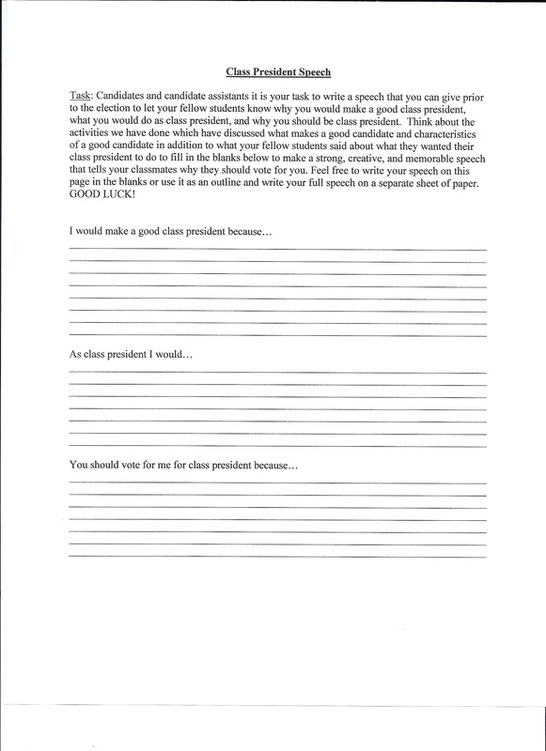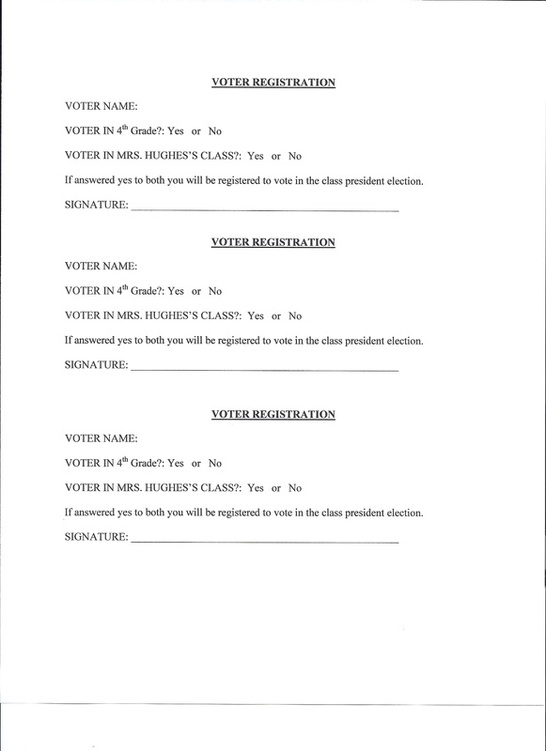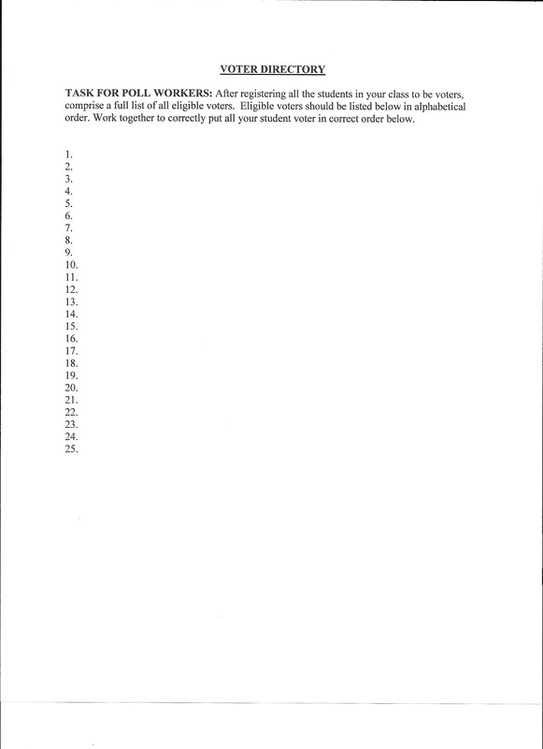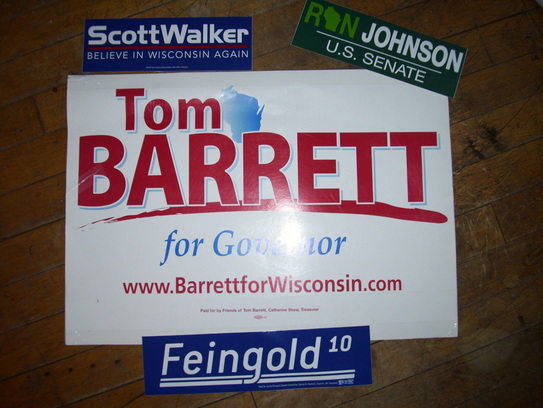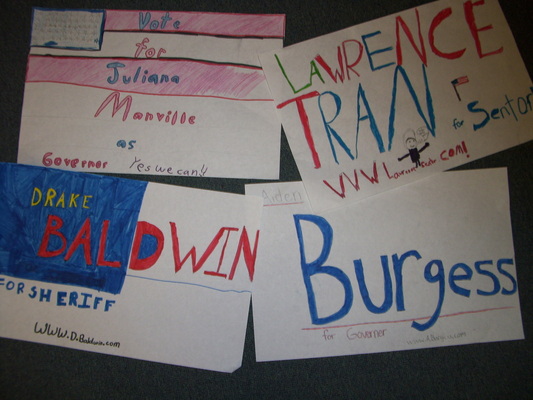Lesson 6: Class President: Campaigning
Teacher: Brittany Hughes
Grade Level: 4th Subject Area: Social Studies
Time Needed: 2 Class periods Topic: Class President: Campaigning
Essential Questions:
· How and why do political candidates campaign?
· What are important characteristics of candidates (both for government and school president candidates)?
· Who are other people who are involved in political elections and how are they involved?
Lesson Goals:
· Students will analyze political signs and discuss the similar and different components of them while reasoning about why these components were chosen.
· Students will create a list of characteristics important to them for their class president to have.
· Students will register to vote for the classroom election.
· Students will design political posters to represent the student candidates in their classroom, write speeches about their ideas for the classroom, and/or register classmates to vote to prepare for the classroom election.
MMSD Standards:
NCSS Standards:
Materials Needed:
· Class President Book
· Chalkboard
· Butcher paper
· Markers
· List of Characteristics of a Political Figure form last lesson
· Political signs
· Poster board
· Speech hand out for candidates
· Voter Registration sheets
· Total Voting List Sheet
· Exit Slip
Lesson Context: This lesson is to be taught towards the end of the unit and allows the students to really get into the campaigning process. The students previously got to pick their role in the classroom campaign process and now they get to experience how the different people involved in elections work together to make it happen. Teachers must be conscious of the students in their class and how they react to the free work time they are given. Students must complete a lot of work and given a lot of freedom so it is important to guide the students and make sure they are on task.
Lesson Opening: Read the next chapter of Class President to the students in the back of the room. After ask the students what they thought of the events of the chapter. Ask them about what happened and what the students in the book were doing to prepare for the lesson. Ask what the candidates were doing to let their fellow classmates know about their thoughts on how they can help make the class a better place. Ask the students which candidate they think would make the best president and why. Ask students who they think will win and way. Also ask students which student seems to care the most and is doing the best campaigning in their opinion. After this discussion tell students that it is now for them to partake in some campaigning of their own.
Procedures:
1. Have students return to their desks. Put an overhead on the board of the students’ names and the position they chose to be for the election. Make sure that each candidate has at least one campaign member to help them in their campaigning process. Teachers should assign which candidate each campaign assistant will be helping to make sure that each candidate has equal help. Tell students to note what position they are and who they will be working with.
2. Explain that their task is now to begin the actions that take place during a campaign. Ask students what are some of the ways they see people running for government officials campaigning. Ask students what kinds of things they see in people’s yards, in the mail, and on television. Students should respond by saying candidates make yard signs, send flyers in the mail, and put ads and speeches on television. Ask students why they think candidates choose to do things like this. Students should be able to recall our discussion from the election process lesson and state that candidates do this type of campaigning to get their name and ideas out to the public and let them know why they should vote for them. Encourage student responses and thinking and explain that we too need campaigning for our election so that we know what each candidate will offer us if he or she is elected class president.
3. Put up various yard signs from different government officials. Ask students to take some time look at the signs. Ask students to volunteer what they notice about the signs. Do they notice any elements of the signs that are common in all of them? Why do you think the candidates chose to design signs like this? What kinds of things do candidates have to think about when coming up with their sign designs? Allow students to answer the questions and discuss with them the different elements they bring up. Write the comments students bring up on the front board so students have a reminder of the elements of the signs that are important throughout the lesson. Students should be able to notice that the political signs are simple, have the candidates last name very large on them, have a color scheme which is appealing to the eye, are very simple and easy to see and read, may have a short slogan on them, etc. Remember to ask students why they think that the signs all have this basic layout. Students should be able to make the connection that these signs are placed in yards for people to see as they walk/drive by. As a result candidates would want people to be able to read them as they drive by so they must be simple and their name must be clear so people can read it and remember it. Ask students if they think designing the posters would be hard work because of all the things that they must think about. Allow students to provide their thoughts and reasoning. Ask students if they have seen any yard political signs when they have been outside. Have students give a thumbs up if they have seen some and a thumbs down if they have not. Ask if any student has a political yard sign in their year. Most students should have seen some signs in yards. You can then make the connection that political signs are a very good way for candidates to get their name out to the public, and as a result the candidates for the class president election are going to be making their own political signs to hang in the classroom so that the class will be reminded of who is running for this position. Tell students that they will be doing this shortly but first we need to discuss another way candidate’s campaign.
4. Next tell students that it is also important for candidates to give speeches to voters. Ask students why they think speeches would be a helpful way to campaign. Allow students to think about the question and respond. Students should be able to use their prior knowledge to respond that speeches allow candidates to tell voters what they plan to do, how they plan to help the voters, what kind of person the candidate is, why the voter should choose that candidate, etc. Agree that speeches can be very powerful for voters and candidates so that voters know about the person they are voting for. Tell the students that the candidates for our class election are also going to be writing a speech to give to the class before the election. Explain to students that the speech should let us know what they plan to do as class president, how they will help all the members of the class, their characteristics that would make them a good candidate, and why we should vote for them. Ask the students how they think should decide what they should write in their speech. Students might suggest looking at the lists we made in the previous class about responsibilities and characteristics of a candidate. Give students the “Candidate Speech” handout for a guideline to writing their speech. Explain that the candidates and campaign assistants now have their duties for the class period. They are to work together to design and create a political poster for the candidate and write a speech that expresses their thoughts and reasons for running for the position.
5. Explain that before the candidate and campaign assistant can start working we have to decide what the poll workers are going to be doing. Ask students what they think a poll worker does. Students should respond that they work where people vote to make sure everyone gets to vote and it is done correctly. Explain that they are right but ask students what must happen before citizens can vote. Students should be able to recall from the election process lesson that voters must be registered. Explain that being registered means that they are able to show that they live in the specific area and meet the qualifications. Ask students what might be some good qualifications for the voters of their election. Students should suggest be a student in this class and in 4th grade. Agree that those are great qualifications and that the poll workers will be going around from person to person to make sure that they are registered to vote in the election. Poll workers will have a piece of paper with the qualifications on it to ask each student and then students must sign the paper to show that they are qualified to vote. The poll workers will then make one master list of all the registered voters for their class.
6. Explain to students that you are now ready to begin working. Write on the board the duties of each position for the day. Write “Candidates and Campaign Assistants – Political poster and speech” and “Poll Workers- Registering Voters”. Remind candidates and campaign assistants that the list of important elements of political posters is on the board as well as the list of important characteristics and responsibilities to help them write the speech. Tell students that if they work hard throughout the day they will receive one Raccoon Dollar for their hard work. Let the candidates and campaign assistants get together and work as well as the poll workers. Hand out the speech worksheets to the candidates as well as a piece of large white paper and markers for them to begin their political poster. Hand out the voter registration forms to the poll workers.
7. Allow the students work on their assigned tasks. Walk around the room monitoring the progress of every student. Assist the poll workers in going from classmate to classmate to get them registered. Make sure that the students are checking the boxes and signing the registration sheets. Also make sure the poll workers make sure to register themselves so that they too can vote. Once the poll workers have successfully registered every student given them the voting roster sheet. Tell the poll workers to put all of the registered voters’ names in the slots in alphabetical order. Inform the students that this will take team work so they must work together. As candidates and campaign assistants make the posters and write speeches ask them questions about why they chose to make their poster look the way it does and say the things they did in their speech. Encourage them to get creative in their speech and add in any other elements that they find important.
Closure/Assessment: Have students clean up their materials at the end of the day. Then have students fill out the following exit slip: “Explain in 3-4 sentences what your position is and what you were responsible for doing today. Why is your role important in an election?” Have the students hand in the slips as they leave and give them each a Raccoon Dollar for working hard for the day. Read through the slips when students leave to assess their understanding of their position and importance in the election.
EXIT SLIP:
Explain in 3-4 sentences what your position is and what you were responsible for doing today. Why is your role important in an election?
________________________________________________________________________________
________________________________________________________________________________
________________________________________________________________________________
________________________________________________________________________________
________________________________________________________________________________
________________________________________________________________________________
Grade Level: 4th Subject Area: Social Studies
Time Needed: 2 Class periods Topic: Class President: Campaigning
Essential Questions:
· How and why do political candidates campaign?
· What are important characteristics of candidates (both for government and school president candidates)?
· Who are other people who are involved in political elections and how are they involved?
Lesson Goals:
· Students will analyze political signs and discuss the similar and different components of them while reasoning about why these components were chosen.
· Students will create a list of characteristics important to them for their class president to have.
· Students will register to vote for the classroom election.
· Students will design political posters to represent the student candidates in their classroom, write speeches about their ideas for the classroom, and/or register classmates to vote to prepare for the classroom election.
MMSD Standards:
- Political Science and Citizenship: Standard 4: Identify the characteristics of responsible citizenship.
NCSS Standards:
- Standard 3: People, Places, and Environments
- Standard 4: Individual Development and Identity
- Standard 5: Individuals, groups, and Institutions
- Standard 10: Civic Ideals and Practices
Materials Needed:
· Class President Book
· Chalkboard
· Butcher paper
· Markers
· List of Characteristics of a Political Figure form last lesson
· Political signs
· Poster board
· Speech hand out for candidates
· Voter Registration sheets
· Total Voting List Sheet
· Exit Slip
Lesson Context: This lesson is to be taught towards the end of the unit and allows the students to really get into the campaigning process. The students previously got to pick their role in the classroom campaign process and now they get to experience how the different people involved in elections work together to make it happen. Teachers must be conscious of the students in their class and how they react to the free work time they are given. Students must complete a lot of work and given a lot of freedom so it is important to guide the students and make sure they are on task.
Lesson Opening: Read the next chapter of Class President to the students in the back of the room. After ask the students what they thought of the events of the chapter. Ask them about what happened and what the students in the book were doing to prepare for the lesson. Ask what the candidates were doing to let their fellow classmates know about their thoughts on how they can help make the class a better place. Ask the students which candidate they think would make the best president and why. Ask students who they think will win and way. Also ask students which student seems to care the most and is doing the best campaigning in their opinion. After this discussion tell students that it is now for them to partake in some campaigning of their own.
Procedures:
1. Have students return to their desks. Put an overhead on the board of the students’ names and the position they chose to be for the election. Make sure that each candidate has at least one campaign member to help them in their campaigning process. Teachers should assign which candidate each campaign assistant will be helping to make sure that each candidate has equal help. Tell students to note what position they are and who they will be working with.
2. Explain that their task is now to begin the actions that take place during a campaign. Ask students what are some of the ways they see people running for government officials campaigning. Ask students what kinds of things they see in people’s yards, in the mail, and on television. Students should respond by saying candidates make yard signs, send flyers in the mail, and put ads and speeches on television. Ask students why they think candidates choose to do things like this. Students should be able to recall our discussion from the election process lesson and state that candidates do this type of campaigning to get their name and ideas out to the public and let them know why they should vote for them. Encourage student responses and thinking and explain that we too need campaigning for our election so that we know what each candidate will offer us if he or she is elected class president.
3. Put up various yard signs from different government officials. Ask students to take some time look at the signs. Ask students to volunteer what they notice about the signs. Do they notice any elements of the signs that are common in all of them? Why do you think the candidates chose to design signs like this? What kinds of things do candidates have to think about when coming up with their sign designs? Allow students to answer the questions and discuss with them the different elements they bring up. Write the comments students bring up on the front board so students have a reminder of the elements of the signs that are important throughout the lesson. Students should be able to notice that the political signs are simple, have the candidates last name very large on them, have a color scheme which is appealing to the eye, are very simple and easy to see and read, may have a short slogan on them, etc. Remember to ask students why they think that the signs all have this basic layout. Students should be able to make the connection that these signs are placed in yards for people to see as they walk/drive by. As a result candidates would want people to be able to read them as they drive by so they must be simple and their name must be clear so people can read it and remember it. Ask students if they think designing the posters would be hard work because of all the things that they must think about. Allow students to provide their thoughts and reasoning. Ask students if they have seen any yard political signs when they have been outside. Have students give a thumbs up if they have seen some and a thumbs down if they have not. Ask if any student has a political yard sign in their year. Most students should have seen some signs in yards. You can then make the connection that political signs are a very good way for candidates to get their name out to the public, and as a result the candidates for the class president election are going to be making their own political signs to hang in the classroom so that the class will be reminded of who is running for this position. Tell students that they will be doing this shortly but first we need to discuss another way candidate’s campaign.
4. Next tell students that it is also important for candidates to give speeches to voters. Ask students why they think speeches would be a helpful way to campaign. Allow students to think about the question and respond. Students should be able to use their prior knowledge to respond that speeches allow candidates to tell voters what they plan to do, how they plan to help the voters, what kind of person the candidate is, why the voter should choose that candidate, etc. Agree that speeches can be very powerful for voters and candidates so that voters know about the person they are voting for. Tell the students that the candidates for our class election are also going to be writing a speech to give to the class before the election. Explain to students that the speech should let us know what they plan to do as class president, how they will help all the members of the class, their characteristics that would make them a good candidate, and why we should vote for them. Ask the students how they think should decide what they should write in their speech. Students might suggest looking at the lists we made in the previous class about responsibilities and characteristics of a candidate. Give students the “Candidate Speech” handout for a guideline to writing their speech. Explain that the candidates and campaign assistants now have their duties for the class period. They are to work together to design and create a political poster for the candidate and write a speech that expresses their thoughts and reasons for running for the position.
5. Explain that before the candidate and campaign assistant can start working we have to decide what the poll workers are going to be doing. Ask students what they think a poll worker does. Students should respond that they work where people vote to make sure everyone gets to vote and it is done correctly. Explain that they are right but ask students what must happen before citizens can vote. Students should be able to recall from the election process lesson that voters must be registered. Explain that being registered means that they are able to show that they live in the specific area and meet the qualifications. Ask students what might be some good qualifications for the voters of their election. Students should suggest be a student in this class and in 4th grade. Agree that those are great qualifications and that the poll workers will be going around from person to person to make sure that they are registered to vote in the election. Poll workers will have a piece of paper with the qualifications on it to ask each student and then students must sign the paper to show that they are qualified to vote. The poll workers will then make one master list of all the registered voters for their class.
6. Explain to students that you are now ready to begin working. Write on the board the duties of each position for the day. Write “Candidates and Campaign Assistants – Political poster and speech” and “Poll Workers- Registering Voters”. Remind candidates and campaign assistants that the list of important elements of political posters is on the board as well as the list of important characteristics and responsibilities to help them write the speech. Tell students that if they work hard throughout the day they will receive one Raccoon Dollar for their hard work. Let the candidates and campaign assistants get together and work as well as the poll workers. Hand out the speech worksheets to the candidates as well as a piece of large white paper and markers for them to begin their political poster. Hand out the voter registration forms to the poll workers.
7. Allow the students work on their assigned tasks. Walk around the room monitoring the progress of every student. Assist the poll workers in going from classmate to classmate to get them registered. Make sure that the students are checking the boxes and signing the registration sheets. Also make sure the poll workers make sure to register themselves so that they too can vote. Once the poll workers have successfully registered every student given them the voting roster sheet. Tell the poll workers to put all of the registered voters’ names in the slots in alphabetical order. Inform the students that this will take team work so they must work together. As candidates and campaign assistants make the posters and write speeches ask them questions about why they chose to make their poster look the way it does and say the things they did in their speech. Encourage them to get creative in their speech and add in any other elements that they find important.
Closure/Assessment: Have students clean up their materials at the end of the day. Then have students fill out the following exit slip: “Explain in 3-4 sentences what your position is and what you were responsible for doing today. Why is your role important in an election?” Have the students hand in the slips as they leave and give them each a Raccoon Dollar for working hard for the day. Read through the slips when students leave to assess their understanding of their position and importance in the election.
EXIT SLIP:
Explain in 3-4 sentences what your position is and what you were responsible for doing today. Why is your role important in an election?
________________________________________________________________________________
________________________________________________________________________________
________________________________________________________________________________
________________________________________________________________________________
________________________________________________________________________________
________________________________________________________________________________
